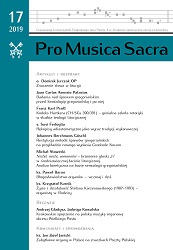Rękopisy adiastematyczne jako wyraz tradycji wykonawczej
Adiastematic manuscripts as an expression of musical performance’s tradition
Author(s): Susi FerfogliaSubject(s): Christian Theology and Religion, Music, Semiology, History of Art
Published by: Wydawnictwo Naukowe Uniwersytetu Papieskiego Jana Pawła II w Krakowie
Keywords: adiastematic and diastematic manuscripts; Gregorian semiology; sonic exegesis; neum; liturgy; Sanktgallen notation and Laon or Metzen notation; Einsiedeln 121; Laon 239; musical performance;
Summary/Abstract: The article aims to depict how studying adiastematic manuscripts can lead us not only to the most faithful interpretation of Gregorian music, but also to the most relevant thing, which is understanding the spiritual and theological content of plainsong. Gregorian chant is a true sonic exegesis, and semiology is the science that – through the question of why this and not another sign was used over a specific neum – opens the way to regaining some performance practice that is not a copy of the past but becomes a liturgical reality today. In this paper two chants from the Midnight Mass form at Christmas were subjected to a comparative analysis: Introitus: Dominus dixit and Communio: In splendoribus sanctorum. The analysis is based on two sources, widely accepted in semiological studies, namely the Einsiedeln 121 manuscript containing the Sanctgallen notation, and the Laon manuscript 239, which gives us the Laon or Metzen notation. On this basis, the idea of the Gregorian composer’s behaviour and the way it influences musical performance were described.
Journal: Pro Musica Sacra
- Issue Year: 17/2019
- Issue No: 17
- Page Range: 63-80
- Page Count: 18
- Language: Polish

